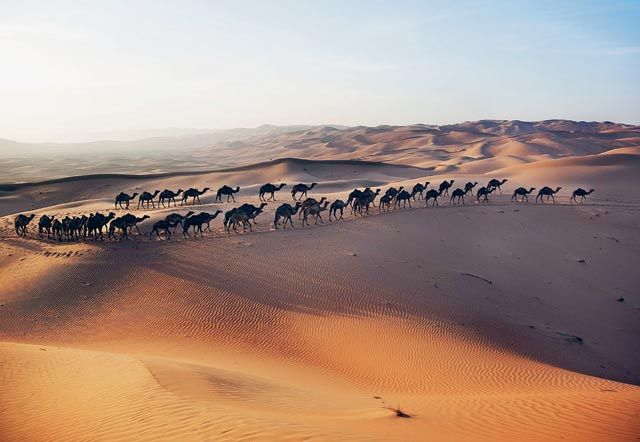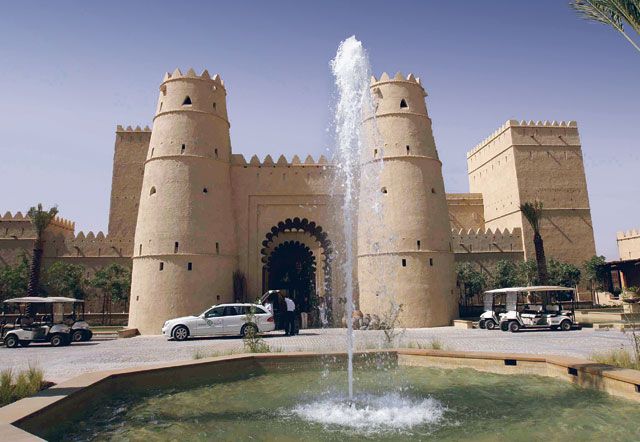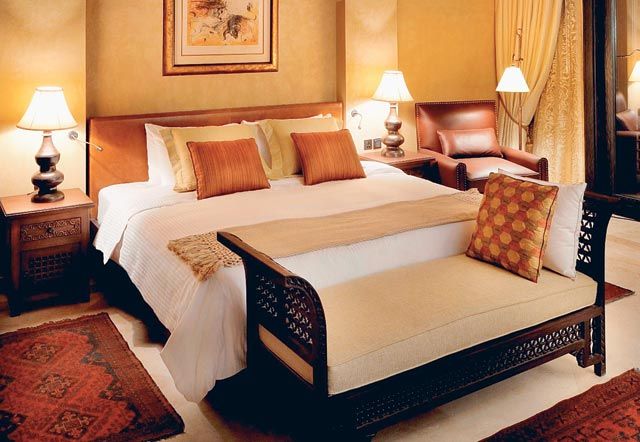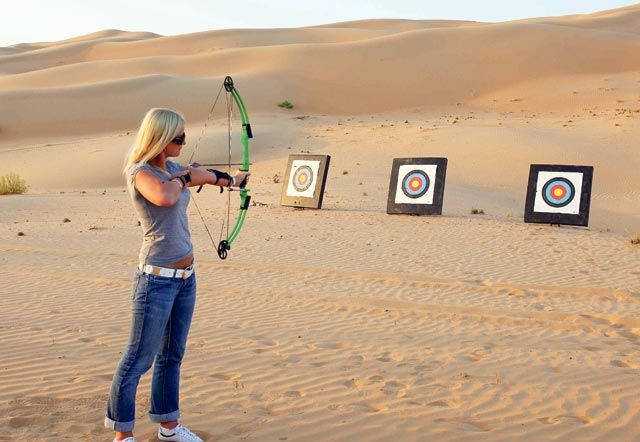The view through the arched balcony seemed very unreal like a framed oil painting. The dunes beyond the royal wing of the hotel glowed dark and light as the sun fell on them. The valley shimmered in the early morning haze. The man-made waterhole close to the hotel glinted like a mirror. Yes, Qasr Al Sarab Desert Resort by Anantara lives up to its name a palace of mirages.
Recently, on a weekend, I was picked up early in the morning from Dubai by my driver Ahmad for a three-and-a-half-hour drive to the new resort beyond Abu Dhabi in the Liwa desert. The trip that I had thought would be long and boring turned into a kaleidoscope of colours.
Deep in the desert
As we sped away from the browns and greys of the twin cities, Ahmad asked me to be on the lookout for a huge Land Rover. Sure enough, we came across the Liwa Car Museum, which also houses an old aircraft.
The silky white dunes, tinged with a hint of gold, slowly gave way to more earthy tones. Soon it felt as if we were sailing through a golden sea with white-crested waves. As we reached the village of Hameem, on the opposite side of the road two huge urns came into view, indicating the way to the resort. We drove deeper into the desert. The sands had changed colour by then and were of a rich copper hue.
We drove through another set of urns into a valley with a village that houses the hotel personnel, before finally reaching the archway to the fort-like structure of the resort.
The architecture is based on ancient homes of the rulers of the area, complete with barjeels and watchtowers.
The hotel has 154 luxurious rooms, 42 villas and ten royal villas with a swimming-pool complex, a fitness centre and a children's entertainment area.
Exotic treatments
The resort's Anantara spa is being designed as a traditional hammam and various packages are on offer — such as the three-day recovery treatment that will leave you feeling "physically, emotionally and spiritually harmonious".
There's an interesting collection of artefacts lining the lobby and library walls.
The Desert Adventures team at Qasr Al Sarab promises to give guests "a true taste of the desert" with falconry, camel trekking, desert walks, mountain biking, archery and desert excursions. The resort is part of a 9,000-square-kilometre wildlife reserve with free-roaming indigenous animals such as the Arabian oryx, sand gazelle and Arabian hare — which explains the man-made waterhole off the pool area.
We were given a tiny taste of what the late British explorer Sir Wilfred Thesiger must have witnessed during his journey across the Empty Quarter between 1945 and 1949. It was late afternoon when we met our set of docile-looking camels. As my companions climbed on to them, I clambered on mine (I would rather ride the scariest rollercoaster any day). "Hold tight," I'd been advised. Bending back as the long hindlegs are raised can topple you pretty easily. By the time the moaning beast raised its forelegs, my palms began to chafe. I saw that some of my companions had decided to walk the salt flat, or sabkha, rather than bear the catwalk of the tall beast.
But Jana, my riding companion, gave some interesting insights into the area and its wildlife as we rode the sabkha. The white salt flat was dotted with stunted green shrubs whose fleshy leaves allow the camels to go without water for days on end.
Camel comrade
One frisky camel, which had refused to take riders kept banging into ours, squeezing our legs into the camel's side, until Jana gave it a not-too-hard nudge with her foot. I felt my camel's hindlegs giving way each time the poor thing tried to climb little dunes while the others seemed to be sashaying by. A long 20 minutes later it was time for us to test our marksmanship.
I didn't score much in the target practice, though I can proudly say I didn't lose any arrows either. The sun was on its way down by the time we all took our turn with the bow.
This time I requested for the "little" camel in the caravan, hoping to climb on it without embarrassing myself. But it simply wasn't my day. I climbed on with a lot less help but my foot got caught in the rope which held the camel behind us (the one I was on earlier).
As Jana helped me out of it I felt this excruciating cramp go up my side.
But soon it was all forgotten. I switched off from my companions' chatter to listen to the silence of the dusk. The soft sound of the camels' footfalls on the sabkha added to the melancholy and even the wind had died down, blowing only in whispers, as the bright landscape began to hide under a dull grey shroud. In my mind I tried to describe the scene but to do that, I'd have to break away from the silence, and I didn't want to. This time the 20 minutes seemed to blink away and we were alighting and moving to our waiting cars almost before we knew it.
Later in the evening we drove under a starry night to our "dining hall" — a traditional Bedouin tent. The meal wasn't bad but the winter tent was a bit stuffy for the early November evening. Also, a gerbil threatening to share our food wasn't so welcome as I'm pretty scared of anything that walks too close to the earth — especially after being told they'd found a snake the previous evening at our shooting site.
We moved out into the cool of the night where the oud player strummed love songs near the bonfire. We sat drinking tea, enjoying some sheesha and looking at the stars in the clear night sky (incidentally, star gazing is on the list of the resort's desert activities), while my host kept reminding me of the 6am desert walk. Throughout the day I had realised walking on the soft sand was not for me, with or without shoes — so decided to give it a miss.
Instead, I just sat in bed and watched the kaleidoscope of mirages through my window instead...
















